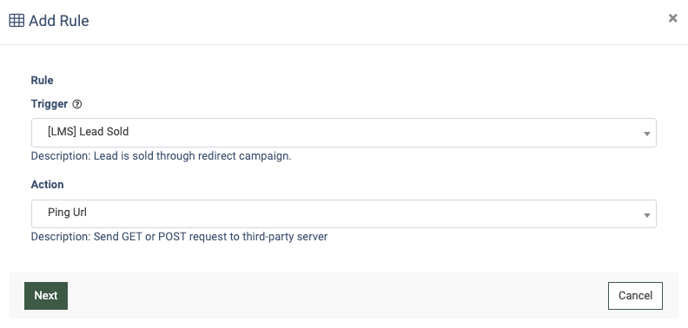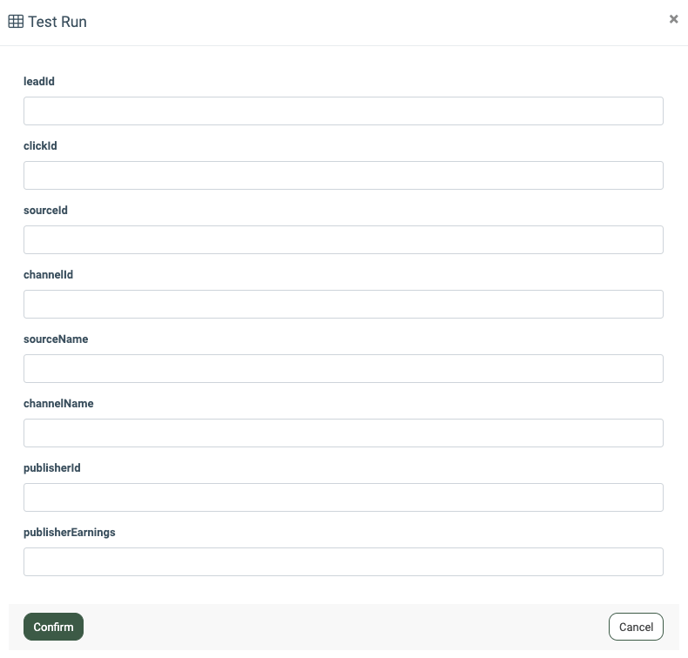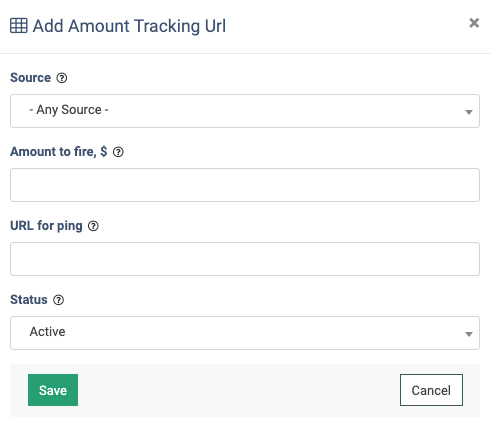Check our short guide on how to use the Publisher Configuration: Tracking tab to access essential tracking settings.
The Tracking tab allows you to set up and configure the process of sending publisher data (such as lead and channel parameters, date, status, earnings, etc.) to your third-party tracking system.
To access, go to the Publisher Management > Publishers section, select the Publisher, and click the “View” button in the “Actions” column. Select the “Tracking” tab on the Publisher setup page.
Tracking Rules
The Tracking Rules block allows you to configure the Event Tracking feature on the Publisher configuration level. Event Tracking allows you to track the various events in the system (e.g., lead sold, lead rejected, publisher earnings received, etc.) and set the actions to be automatically triggered by them.
The list of Event Tracking Rules contains the following information:
- ID: The unique identification number of the rule.
- Trigger: The name of the trigger that is set in this rule.
- Trigger Settings: The list of settings for the trigger.
- Action: The action to perform according to the rule.
- Action Settings: The list of settings for the action.
- Status: The status of the rule (Active/Disabled).
- Created At: The date and time of the rule creation.
- Author: The name of the user who created the rule.
- Adjacent Rules: The number of tracking rules that can be applied simultaneously with the selected rule. Click on the number to see the list of rules that can run concurrently. To go back to the full list of tracking rules, click the “Reset” button.
To set up the feature, click the “Add Rule” button.
Select the required options in the “Add Rule” pop-up window:
- Trigger: Select the event that triggers the action. Note: The variation of triggers differs for every event type.
- [Call Logic] Lead Rejected: The lead was rejected by the Publisher.
- [Call Logic] Lead Sold: The lead was sold to the Publisher.
- [Call Logic] Publisher Earning Received: The Publisher has received earnings.
- [LMS] Lead Rejected: The lead is not accepted by any Campaign.
- [LMS] Lead Sold: The lead is sold through the Campaign.
- [LMS] Publisher Earning Received: The Publisher has received earnings.
- Ping URL
- Pixel
- Google Analytics
- Facebook Conversion
- Trusted Form Claim
- Twilio
- Add to Five9 List
 To test the existing tracking rule configuration, click the “Test Run” button in the “Actions” column. Fill in the test data in the provided fields (not mandatory) that match the tracking rule configuration placeholders.
To test the existing tracking rule configuration, click the “Test Run” button in the “Actions” column. Fill in the test data in the provided fields (not mandatory) that match the tracking rule configuration placeholders.
 Click the “Confirm” button to complete the test run. Once the test run is executed, the result is displayed in the “Tracking Log” report via the “Test Runs” tab. Read more about the Tracking Log report in the following article.
Click the “Confirm” button to complete the test run. Once the test run is executed, the result is displayed in the “Tracking Log” report via the “Test Runs” tab. Read more about the Tracking Log report in the following article.
To edit the existing rule, click the “Config” button in the “Actions” column.
To delete the rule from the system, click the “Delete” button in the “Actions” column.
Amount Tracking
The Amount Tracking block allows you to manage the notifications (pings) about reaching the predefined threshold for the amount on the Publisher’s balance.
To configure the option, click the “Add Amount Tracking URL” button in the “Amount Tracking” block.
Fill in the following fields in the “Add Amount Tracking URL” pop-up window:
- Source: Select the Publisher Source.
- Amount to fire, $: Enter the amount of money upon reaching which a ping will be sent.
- URL for ping: Enter the URL for ping.
- Status: Select the pixel status (Active, Disabled). Note: If the “Disabled” status is selected, the pixel won't fire and won't calculate.
 Click the “Save” button to confirm.
Click the “Save” button to confirm.
Example:
Assume that in the “Amount to fire” field 20.00 USD value is entered. The Lead with the 5.00 USD price is sent by the Publisher and is sold. The data about this action will be recorded and displayed in the Publisher Report, but the ping notification itself will not be sent because the Lead’s sold price is lower than 20.00 USD.
Then, the Lead with the 40.00 USD price will be sent by the Publisher and is sold, and the total amount the Publisher has at the current moment is 45.00 USD (40.00 + 5.00). Because this amount is higher than 20.00 USD, the Publisher will receive a ping notification.
Google Analytics
In the “Google Analytics” block, you can find instructions about the Google Analytics implementation on your website. By clicking on the Google Analytics tracking and Google Analytics ID link you will be able to see information from Google Support about Setting up the Analytics Google tag. Enter your Google Analytics ID in the field from step 2, then copy and paste the script from step 3 to your webpage.
To save the Google ID, click the “Save Google ID Analytics” button to complete the action.
Google Ads
The Google Ads block contains instructions about the Google Ads implementation.
To make the integration with the Google Ads service, copy the code from the corresponding field and put it in the Google Ads > Bulk operations > Scripts section, and set the Schedule> Hourly section. To obtain additional information about this service, click the “Documentation” button and view the details in the “Add URL” pop-up window.



